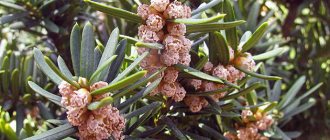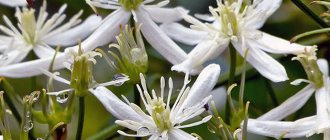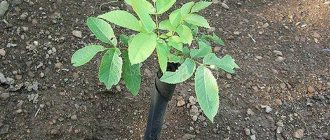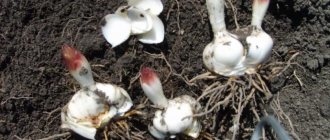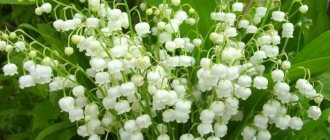27.03.2018 0
5685
Gardeners looking for a spectacular flowering shrub for their garden should pay attention to Kuril tea - an unpretentious, long-flowering plant, available in many varieties. It is easy to learn about the intricacies of growing it in open ground and the variety of varieties, about the features of planting and care by reading this material.
Description
Kuril tea is a highly branched bush that creates a lush, dense crown that looks like lace. The height of the plant varies from 20 to 150 cm, and the average width is 110 cm. Silky fresh shoots become brown in color after a short period. The bright green leaves are covered with soft, thick silvery hairs.
All types of cinquefoil have lacy, carved leaves, divided mainly into five lanceolate-shaped lobes, but there are specimens with three or seven lobes. The egg-shaped stipules grow together with the cuttings. The large flowers are wide open, flat and consist of five petals. There are single or collected in inflorescences in the form of a brush. The petals are mostly colored in a beautiful, rich yellow color.
Some types of Kuril tea (cinquefoil) have pink or white flowers. Flowering is constant, long-lasting, from the beginning of the summer months until mid-autumn. Some types of cinquefoil, under favorable conditions, delight with flowering, right up to the appearance of the first snow. Flowers bloom along the entire length of the shoots. The fruits are pubescent, sickle-shaped achenes that ripen in late August. The plant begins to bear fruit in the second year after planting and then annually. Under good conditions, a tea bush can grow in one place for up to 30 years.
What kind of plant is this
Kuril tea is a beautiful spreading shrub with delicate velvety carved leaves of light green color, “laid” in a spherical crown. Each leaf resembles a small five-pointed fan.
Kuril tea has many varieties, plus breeders are constantly creating decorative varieties . In nature, the bush grows up to 1.5 meters , today you can already buy miniature varieties that barely reach 60 cm. The bush blooms for a long time - from the time when the weather is warm until the frost, therefore it is desirable in the garden. The flowers are usually yellow, but there are also bright orange, red, pink and cream shades. Flowering occurs singly or in inflorescences.
The plant has an unusual “tea” name, this is due to the fact that in the Kuril Islands they drank it instead of regular tea. After all, Kuril tea has won people’s love not only because it is distinguished by its beauty. Its beneficial properties are also known, which is why it is consumed as tea. The leaves contain anti-inflammatory and antibacterial components; tea made from them perfectly tones and strengthens the immune system. Used to improve the functions of the heart and liver. This is a good remedy for depression and neuroses.
Varieties and types
There are several dozen of them, which differ in the height of the bush, the color of the petals and leaves. What all varieties and species have in common: deciduous, perennial plants, highly branched crown. Silvery, upright, goose, and creeping cinquefoil are the most popular types.
Some plant varieties:
- Kobold. The flowers are light yellow in color. A fast-growing bush that requires regular pruning.
- Goldstar. The height of the bush reaches one meter. The lace crown is up to one and a half meters in diameter. This is a frost-resistant variety, the yellow flowers are large and rare. Flowering is long lasting.
- Princesses. Enlivens the garden with pink flowers.
- Red Ace. Bush up to 70 cm high. Blooms from July until almost frost. Petals are orange-red.
- Abbotswood. The most popular variety with snow-white flowers.
Colorful colors
The five-leaf plant has more than a dozen varieties. They differ in the color of flowers (from white, yellow and orange to pink and red) and leaves (from light green to grayish blue), as well as in the height of the bushes. In the climate of central Russia, low-growing cinquefoils with yellow or white flowers are considered the most resistant. Orange-, pink- and red-flowered ones are “capricious” more often.
| Popular varieties of cinquefoil bush | |||
| Name | Flower color | Bush height | Note |
| 'Abbotswood' | white | 1m | dense bush, good for borders |
| 'Goldfinger' | yellow | 1.5 m | large flowers (up to 5 cm), very unpretentious |
| 'Tangerine' | orange | 0.6 m | flowers change color from yellow to copper |
| 'Royal Flush' | from dark pink to red | 0.5 m | beautiful autumn color of the bush |
Kuril tea. Photo: Commons.wikimedia.org
Reproduction
Using the vegetative method: using green or lignified cuttings, root shoots or layering, and dividing the bush, Kuril tea is planted and grown.
Propagation by seeds is preferable when breeding species of plants. They are planted in the spring to produce seedlings. To do this, the seed material is sown densely and not buried. About thirty days after sowing, young sprouts are planted in open ground.
Growing
Kuril tea, or shrubby cinquefoil, is a frost-resistant plant that can grow in poor soils. Therefore, there are usually no problems when growing it. Kuril tea is propagated by seeds, dividing the bush or cuttings. Seeds are sown in open ground in the spring and the young seedlings have time to grow stronger by autumn.
To quickly propagate Kuril tea, you can cut several green cuttings in the spring and root them in a greenhouse. The rooting rate of such cuttings is almost 90%, but before planting they are kept in a root solution or other root-stimulating preparation. Kuril tea is planted in a permanent place next spring.
Yellow cinquefoil in home gardening
Growing Kuril tea must begin with choosing a suitable location. Although it is unpretentious, it grows much better in a sunny place and light soil than in the shade and on a clay area. If you plan to plant several Kamchatka tea bushes, maintain a distance of 40 cm between them. In this case, they will grow well and turn into a hedge.
Caring for cinquefoil consists of the following activities:
- annual sanitary pruning of bushes in early spring;
- watering in dry summers;
- feeding with complex fertilizers during the budding period.
Young shrubs need to be cared for more carefully. In the first year after planting, it is covered for the winter if the region is characterized by cold winters. Watering is also carried out more often, and fertilizing is done in the spring during the period of active growth, then before flowering and during the period of active flowering. In the first year of life, it is better to pick the buds from the bush so that it becomes stronger and will delight you with lush greenery and an abundance of inflorescences next year. The grass should be weeded so as not to interfere with the growth of the seedling. The photo above shows an option for using cinquefoil in landscape design.
If the shrub is propagated for the purpose of obtaining medicinal raw materials, then it is better to refuse fertilizing. In this case, caring for Kuril tea comes down to fertilizing and sanitary trimmings. In Kamchatka it is collected from wild plants, and in this form it meets all safety characteristics.
Choosing a landing site
All types and varieties of Kuril tea, care and cultivation are not particularly difficult; to obtain the maximum number of flowers, they should be cultivated in an open sunny area, protected from the wind. The plant feels comfortable in proximity to trees and other shrubs that protect the cinquefoil from direct sunlight and provide light shading. However, it should be remembered that the plant should not be in the shade for most of the daylight hours. The most unpretentious varieties are those with yellow and white flowers.
Varieties with flowers painted yellow are the most frost-resistant. Tea bushes with pink flowers should be covered in winter and fed more often. They bloom later than yellow-flowered varieties.
Planting cinquefoil bush
Kuril tea is distributed almost throughout the planet, but the plant especially loves temperate climates.
Does not suffer much from some drought, and is also not afraid of cold weather. It can be found in the mountains, in forests, in fields, near water and far from it. so choosing a landing site on the site will be quite simple. A lowland, a small hillock, an open space, and shade are suitable. Although it is optimal if the chosen location has moderate sunlight.
Before planting, it is necessary to prepare the soil. To do this, dig up a layer of soil at least 30 cm deep in the fall or early spring and add humus and clean coarse sand mixed with the soil. It is better to plant cinquefoil in spring.
Seeds can be purchased at any seed store. Before planting (preferably in April), clear the soil of weeds and loosen it thoroughly. Sow the seeds at some distance from each other, cover lightly with soil and water thoroughly. The first shoots will appear in about a month. They will need to be thinned out later. The distance between neighboring plants should be about 30 cm.
Planting a plant
There are some peculiarities in the care and planting of Kuril bush tea. Reproduction is possible in several ways, which are listed above. Cinquefoil prefers light loamy soils. The root system is located close to the surface, so when loosening, care must be taken not to damage the roots of the bush. When growing on clay soils, drainage is done using lime gravel. Planting Kuril tea in sandy soils reduces its decorative value. In central Russia, tea is planted in late April or in the autumn months.
Before planting the plant, about two weeks in advance, a hole measuring 60 by 100 cm is dug and drainage is made, the layer of which should be at least 20 cm. The planting hole is filled to ½ volume with a specially prepared mixture of leaf soil, humus and sand (in a ratio of 2: 2 : 1). When planting, the root collar is not buried, but left at ground level. The distance between bushes is at least 50 cm (for the purpose of further formation of hedges or flowering continuous borders) and up to 120 cm for single plantings.
Methods for propagating cinquefoil
Kuril tea is propagated by seeds, cuttings (green, lignified) and vegetative methods - by dividing the bush, layering. The last three allow you to grow a shrub that is as similar as possible to the parent plant and preserve the qualities of the selected variety.
Seeds
The seed remains viable throughout the entire storage period. The method is popular among gardeners, but has a number of disadvantages: not all seeds germinate, the grown plant begins to bloom only in the second, third or even fourth year and does not always retain the varietal qualities of the cinquefoil bush.
Seeds are sown directly in open ground in the fall or seedlings are grown. During the winter, seeds in the open ground undergo natural stratification (hardening), and in the spring the first shoots appear. Seedling method of propagation of Dasyphora:
- Stratify the seeds for three months. First moisten with warm water and then place in a cold place (t +5˚C).
- At the end of February - beginning of March, sow in containers with a soil mixture of leaf soil and sand (2:1).
- Cover the boxes with cling film and place them in a room with an air temperature of +15-18 ˚C.
- Water carefully using a spray bottle.
- When the first true leaves grow on the seedlings, plant them in separate containers.
- When the seedlings begin to actively grow, fertilize them with a complex mineral composition or an aqueous solution of manure (1 part humus to 20 parts water).
- In the summer, harden the seedlings, and at the end of summer or beginning of autumn, plant them in a permanent place.
Dividing the bush
This method of reproduction has no disadvantages. Its advantages include: almost 100% survival rate of planting material, complete reproduction of the varietal qualities of the plant. For the procedure, plants that are 4–6 years old are used. The procedure is carried out at the end of April or autumn (only in regions with a warm climate). How to do it correctly:
- Using a pitchfork (so as not to damage the roots), dig out an adult bush.
- Shake off the root system, rinse with warm water and divide into sections with pruners or a hatchet. Each of them must have roots and at least 2-3 buds.
- Treat the measles system with the growth stimulator "Kornevin", cut the seedlings to 20–30 cm (leaving the buds).
- Plant each seedling in the prepared holes, and the old bush in its original place.
- Provide young shrubs with the same care as adults.
- If everything is done correctly, new plants will bloom this year.
By layering
Reproduction of cinquefoil shrubby layering has no disadvantages. The advantages are the same as those of the propagation method by dividing the bush. Step-by-step instruction:
- Dig a shallow ditch next to the bush.
- In the summer, select the most developed, strong shoot, make cuts on it at the point of contact with the ground, press it to the ditch and secure it with stiff wire staples.
- Cover the top with soil and water. Care for it in the same way as for an adult shrub.
- The roots on the layering will form within 10 days, but the shoots have not yet become strong and do not need to be touched.
- Next spring, separate the root children from the mother bush and plant them as young seedlings. Provide the same care as for other bloodroots. If grown correctly, the cuttings will bloom the next year.
Propagation of cinquefoil bush cuttings
The planting material takes root almost 100%, the varietal qualities of the plant are fully reproduced. The method has no disadvantages. How to prepare and root green cuttings:
- In late spring - early summer, cut young, non-lignified cuttings from a healthy bush along with the leaves. Do this in cloudy weather or before sunrise.
- Choose non-flowering shoots of medium size.
- Cut the cuttings 8–12 cm long, leaving 2–4 internodes on them.
- Make the bottom cut 0.5–1 cm from the bud, the top cut just above the bud.
- Before planting, treat them with a disinfectant.
- Plant directly into the ground, deepening it so that the cutting rises 1–1.5 cm above the soil. Choose a semi-shaded area.
- Cover with a glass jar or cut plastic bottle.
- Spray with a spray bottle for the first few days, and when the seedlings take root (after 6-8 weeks), care for them in the same way as adult plants.
- Cut off the resulting buds so as not to take away from the bush the strength necessary for growth.
How to propagate cinquefoil using lignified cuttings:
- You can take cuttings any day from spring to early autumn.
- Do not plant them immediately, but bury them in plastic or clay containers with drainage holes, drainage and a substrate of peat, humus, sand and vermiculite. Add nitrogen, potassium and phosphorus.
- Place the containers in a room where there is no direct sunlight, constantly moisten the substrate.
- Plant rooted cuttings in the spring, in cloudy or rainy weather. 2 weeks before, start hardening them - open the windows or take the containers outside.
Kuril bush tea: planting and care
The plant grows well in rocky soils. It is possible to plant and replant cinquefoil after the snow melts, as well as in early September. During prolonged dry weather, the plant is regularly watered and sprayed for three weeks after planting. Next, carry out one-time abundant watering in the evening (no more than three times during the entire summer period), pouring up to 12 liters of water under the bush, then mulch with humus.
The first fertilizing is applied immediately after planting and consists of mineral fertilizers (20 g), wood ash and lime (150 g). The second feeding is done immediately before flowering. Potassium-phosphorus fertilizer is dissolved in water (the proportions are indicated in the instructions for use) and the plant is watered at the root. Timely application of fertilizing results in abundant flowering.
Fertilizer and fertilizing used in growing Kuril tea
The first feeding of Kuril tea is done at the time of planting in a permanent place. To do this, use organic matter or mineral fertilizers, which are introduced into the tree trunk circle. Then, annually, starting from the second year of planting, it is recommended to feed perennial cinquefoils several times during the season using organic matter or mineral fertilizers:
- in early spring, applying fertilizers for flowering plants;
- before flowering, using potassium-phosphorus fertilizer;
- in the fall to provide the bushes with good winter hardiness.
Attention! When growing annual cinquefoil, the site is fertilized during the autumn digging of the soil, after the faded plants have been removed.
With regular feeding, lush flowering of Kuril tea is guaranteed.
Plant pruning and crown formation
After planting Kuril tea, shrub pruning and care are required. Once every five years, anti-aging pruning is carried out.
To do this, at the very beginning of spring, all branches are cut off completely, leaving no more than 15 cm, then fertilized using mineral fertilizers with a high nitrogen content, as well as chicken droppings diluted in water. Every September the crown of the plant is formed.
Beneficial healing properties
After a course of drinking Kuril tea, the following changes occur in the body:
- The functioning of the nervous system is strengthened.
- The functioning of the gastrointestinal tract improves.
- Inflammatory processes are eliminated.
- Immunity increases.
- Motor and respiratory activity is stimulated.
- Excess fluid is removed from the body.
Kuril tea tones, restores beneficial intestinal microflora, kills bacteria, increases energy and endurance. In the female body, the reproductive system undergoes healing, pain during menstruation and uterine bleeding are eliminated, and erosions heal.
Diseases and pests
Kuril bush tea (planting and care is simple) is resistant to diseases and is quite rarely affected by pests. Sometimes the leaves are overcome by rust, and brown spots appear on them, casting a yellowish or purple color. At the first signs of disease, the plant is sprayed with special chemicals or treated with sulfur or an emulsion containing copper and laundry soap. The causes of this fungal disease are dampness, too dense soil and proximity to diseased trees or shrubs.
Landing highlights
For successful acclimatization, the plant must choose “local” varieties. There are many ornamental shrubs, the colors of which can range from snow-white to red. Plants with yellow or orange petals are considered the most resistant to frost and adverse conditions. Red and purple varieties need additional shelter for the winter, but much also depends on growing conditions and proper care. In the first year, it is desirable to provide the plant with the most suitable conditions for successful rooting, so it is worth familiarizing yourself with the planting rules in more detail.
You may be interested in: Tibetan collection. Cooking recipes
How to plant a purchased bush:
- A plant with a closed root system has a greater chance of successful rooting, so it is better to purchase bushes in a container.
- The plant is planted around mid-April, when the ground has warmed up enough and the risk of frost has passed. It is not worth planting cinquefoil in the fall, because the young seedling will not have time to take root and may die.
- The planting hole is dug in advance, having prepared a nutrient mixture at the bottom. To do this, the top soil is mixed with humus, wood ash and lime. It is also advisable to use complex mineral fertilizers, especially on depleted soils.
- The distance between plants in group plantings is maintained at approximately 60-80 centimeters, depending on the height of the bush.
- The seedling must be planted at growth level in a container. The root collar does not go deep, the soil around the bush is compacted tightly and watered abundantly. It is advisable to immediately mulch the tree trunk circle. This will help retain moisture and also make further care easier.
An adult plant can be successfully propagated in different ways. The method of dividing the bush and propagation by cuttings is usually used. Growing a bush from seeds will require a lot of time and effort, so this method is less popular.
What are the benefits of Kuril tea?
Covering the roots with a layer of mulch for the winter, infrequent watering and fertilizing are minimal measures when caring for cinquefoil. The beneficial properties of Kuril tea have long been used by hunters; they knew about its anti-inflammatory effect and, in order to protect themselves from viral infections, they threw one pinch of tea into hot water. A remedy that gives strength - that’s what they thought in the old days. Medical sources contain information that an infusion made from Kuril tea can neutralize rotavirus and even vibrio cholera.
A decoction of Kuril tea, due to the content of cobalt, potassium, manganese, iron, calcium, increased presence of ascorbic acid, vitamin A, PP, tannins, essential oils, taken orally, strengthens the immune system and improves the external condition of the skin. A decoction of Kuril bush tea (planting and care is described above) is used:
- in surgery and traumatology - for washing wounds;
- in dermatology - for various inflammatory diseases of the dermis;
- in ophthalmology - in the treatment of conjunctivitis and inflammation of the tear ducts;
- in dentistry - for the treatment of gums;
- in endocrinology - for pathology of the thyroid gland;
- in gastroenterology - for poisoning, dysbacteriosis;
- in urology - for cystitis, pathologies of the urinary tract;
- in gynecology - with inflammation of the appendages, with heavy menstruation;
- in cosmetology - for taking baths, strengthening hair and protecting it from oily shine.
Kuril bush tea is also widely used in folk medicine. Consumer reviews note its positive effect in treatment:
- pneumonia and bronchitis;
- sore throats, colds;
- vaginitis, colpitis.
Gardeners (both professionals and amateurs) prefer cinquefoil when decorating gardens, parks, squares, flower beds, landscaping slopes, and also use it as hedges.
Methods of preparation and use
Basically, traditional medicine suggests making healthy tea based on the cinquefoil bush. You can also prepare infusions and decoctions, alcohol preparations and rubbing compositions from the plant.
Tea
You need to brew Kuril tea in almost the same way as regular tea. The diagram looks like this:
- A large spoonful of dry leaves and flowers is crushed.
- Pour the raw materials into a ceramic teapot and pour a glass of boiling water.
- Leave covered for ten minutes, then strain.
Take cinquefoil tea up to 750 ml per day. A single dosage is 250 ml.
You can take Kuril tea for chronic fatigue and vitamin deficiency
Decoction
A concentrated decoction of yellow cinquefoil is beneficial for intestinal infections and bleeding. The product is prepared according to the following algorithm:
- Grind two large spoons of dry herb from the plant.
- Pour 500 ml of hot liquid into an enamel pan.
- Bring to a boil and simmer over low heat for seven minutes.
- Leave covered for ten minutes and strain.
We recommend reading: Cahors: beneficial properties and contraindications
The product is consumed 150 ml up to three times a day.
A decoction of yellow bush cinquefoil helps with dysbiosis and kidney diseases
Infusion
If you are prone to edema, with kidney inflammation and abdominal pain, you can use an aqueous infusion of cinquefoil bush. It is prepared like this:
- Three large spoons of dry stems and leaves of the plant are poured into a thermos.
- Pour the raw material with two glasses of boiling water.
- Seal the container and leave for two hours.
- After the expiration date, filter.
The infusion is taken 100 ml on an empty stomach up to four times a day.
For a sore throat and sore throat, you can gargle with a warm infusion of bloodroot.


